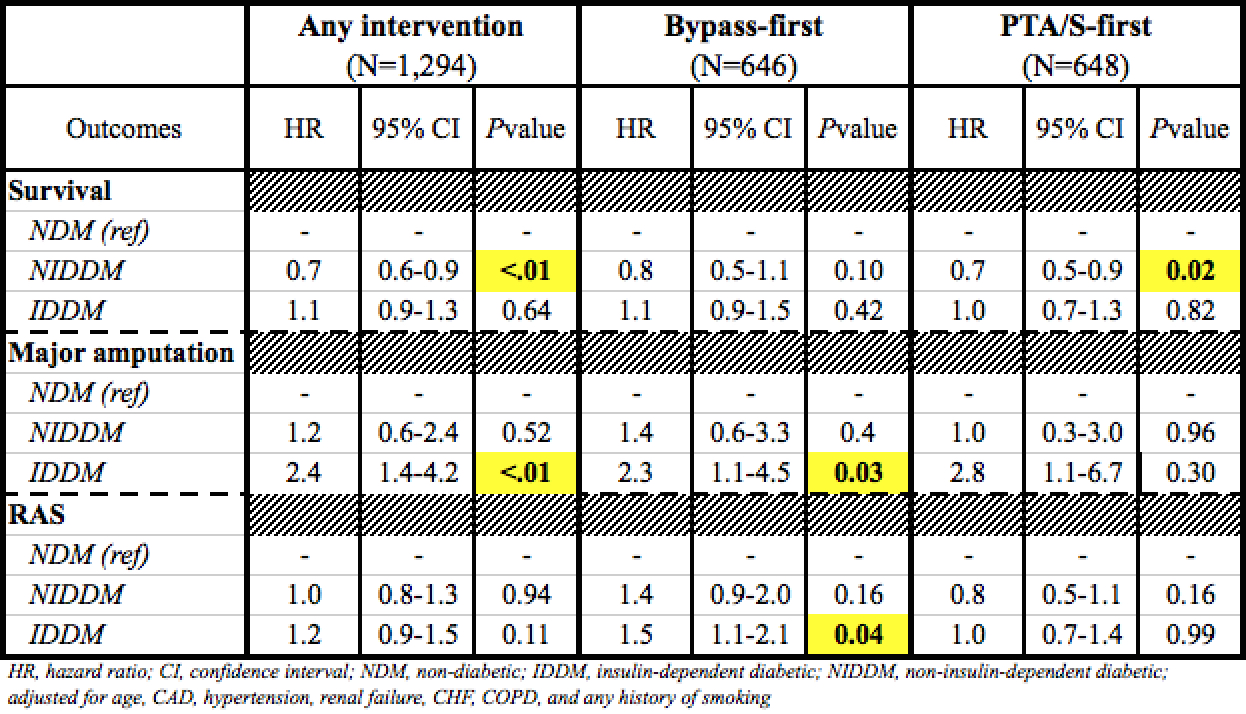The impact of insulin dependence on lower extremity revascularization outcomes in chronic limb threatening ischemia
Jeremy D. Darling, B.A., Sarah E. Deery, M.D., Gabrielle Yee, B.S., Thomas Bodewes, M.Sc., Raul J. Guzman, M.D., Mark C. Wyers, M.D., Allen D. Hamdan, M.D., Marc L. Schermerhorn, M.D..
Beth Israel Deaconess Medical Center, Boston, MA, USA.
OBJECTIVES: Diabetic patients with limb threat have been shown to have excellent results following bypass in regards to operative mortality, graft patency, and limb salvage. In the current endovascular era, we sought to evaluate these findings in insulin-dependent and non-insulin-dependent diabetic patients for first-time bypass and endovascular interventions. METHODS: We reviewed all limbs undergoing a first-time infrainguinal bypass or percutaneous transluminal angioplasty (PTA/S) for chronic limb-threatening ischemia (CLTI) at our institution from 2005-2014. Based on preoperative medication regimen, patients were categorized as insulin-dependent diabetic (IDDM), non-insulin-dependent diabetic (NIDDM), or non-diabetic (NDM). Outcomes included survival, limb salvage, and RAS events (revascularization, major amputation, or stenosis). Outcomes were evaluated using Chi Squared, Kaplan-Meier, and Cox regression analyses. RESULTS: Of 2,869 infrainguinal revascularizations from 2005-2014, 1,294 limbs (646 bypass, 648 PTA/S) fit our criteria and underwent a first-time revascularization for CLTI. Overall, 703 IDDM, 262 NIDDM, and 329 NDM limbs were included in our analysis. IDDM patients were younger (69 vs. 73 vs. 77 years; P<.001) and more often presented with tissue loss (89% vs. 77% vs. 67%; P<.001), coronary artery disease (57% vs. 48% vs. 43% P<.01), and end-stage renal disease (26% vs. 13% vs. 12%; P<.001). There was no difference in the proportion of groups undergoing a primary bypass procedure (49% vs. 51% vs. 52%; P=.58). Regardless of intervention type, IDDM patients had a significantly lower limb salvage rate at 5 years (Bypass: 74% vs. 84% vs. 90%, P<.001; PTA/S: 79% vs. 91% vs. 95%, P<.001). Multivariable analyses illustrated that IDDM significantly increased the risk of major amputation following any first-time intervention (Hazard Ratio (HR) 2.4, 95% Confidence Interval [CI] 1.4-4.2) and a bypass-first intervention (2.3 [1.1-4.5]), as well as RAS events following a bypass-first intervention (1.5 [1.1-2.1]) (Table I). NIDDM was shown to protect against mortality following any first-time intervention (0.7 [0.6-0.9]) and a PTA/S-first intervention (0.7 [0.5-0.9]). CONCLUSIONS: In the current endovascular era, insulin-dependent diabetics present at an earlier age and with more severe disease. Importantly, these patients have similar mortality to non-diabetics, but have an increased risk of major amputation and future RAS events, especially following a first-time bypass. 
Back to 2017 Program




